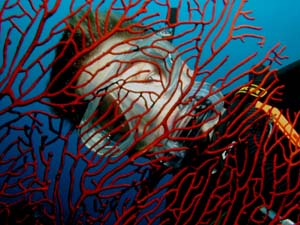Shoot
Now - Ask Questions Later!
"Thinking
Digital" in Underwater Photography
Digital
photography is a new technology which requires learning new techniques and
developing new habits. The first instinct of any film photographer is to
simply apply the old ways of thinking to the new medium. This will
ultimately prove frustrating. While you may reap the more obvious
advantages of digital photography, you'll probably (unnecessarily) suffer from
its perceived shortcomings, and ultimately you'll fail to benefit fully from the
digital revolution.
There are
three ways that digital photography fundamentally differs from film photography:
Immediate
Review - Film needs to be developed. Even in this age of
ubiquitous one-hour photo shops, you still must shoot and hope you've captured
the moment. With a digital camera, you can instantly see your shot.
Zero
Incremental Cost per Shot - Film costs money, roughly proportionally
to the number of frames you shoot. While storage bits actually have some
finite cost, they are so inexpensive as to be trivial. I archive all my
shots on CD-R, which (today) costs roughly a nickel to save 100 6M pixel
shots. If that's still significantly more than zero cost for you, consider
deleting all but your best - at least then the "incremental" deleted
shots are truly free. Use rechargeable batteries to make sure the
incidental costs are also zero.
Flexible
Processing - Custom prints are expensive, and darkroom work is
slow. Photoshop (or similar programs) perform miracles on mediocre
shots. You can trivially compensate for exposure errors, adjust color
balance, and spot away backscatter. Some may call it cheating, but in
reality it's just using good tools.
These facts dictate a number
of changes in the way to take pictures underwater:
Shoot
Now, Ask Questions Later - That's the basic rule in digital
underwater photography. The constraints film rolls and processing delays
have been blown away, and now there's no excuse not to take a picture. The
more shots you take, the more keepers you'll collect. You're probably
already using your equipment to optimize your bottom time as best you can.
So the new techniques are based on the simple question: What can I do to
allow me to take more pictures during my bottom time?
Maximize
your Capacity - To the extent you can afford it, set up your camera
to take advantage of free shots. Buy the biggest "digital film"
memory module you can afford - two hundred shots is not too many. Use high
capacity (1600 mAH) NiMH batteries, and plan to reload both memory module and
batteries between dives. By doing so, you will never be limited by the
capacity of your camera. You can shoot every opportunity.
Postpone
Decisions - Don't delete photos underwater - the time required to
distinguish keepers is too precious. Instead, use your generous capacity
to allow you to make critical decisions topside.
Don't
Bracket it, Try it - Generally, don't spend more than a few seconds
determining your exposure settings and lighting arrangements. Instead,
fire off a shot and check it out. You can judge overall exposure and
lighting from the LCD in an instant. Then you can adjust accordingly and
shoot again. Of course you can't always do this - if the subject will flee
when the strobe fires, you need to be sure of your settings. Also, don't
abandon the idea of bracketing exposures. The dynamic range of digital
photos is limited, so you can't always compensate for inaccurate exposures
later. Consequently, with many subjects taking a handful of shots at
varying settings is worthwhile. But base those settings on what you see,
not on calculations. Use that immediate feedback!
Post-Process
- There's no need to use the fancy features of your digital camera. You
can sepia tone or color enhance the shots topside. Even color balance is
relatively unimportant - Photoshop's adjustments do basically the same thing in
the same way as the camera's color balance processing. The object
underwater is to grab as much quality raw image data as you can. You can
refine it while degassing.
 |
|
Get
Creative - Some of our best shots (such as my son's self-portrait at
left, which he took at 90 ft. in Fiji) have come from wild narked-out ideas
that just occurred in the moment. Since film is free, why not? And
since you can see the results immediately, you can quickly evolve new styles.
|
